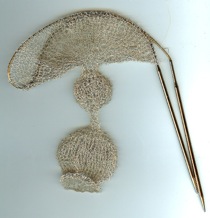Oct 2007
Initial Sampling
01/10/07 23:24 Filed in: Introduction
Sampling
01/10/07 16:11 Filed in: Introduction
Textile Processes
01/10/07 15:00 Filed in: Introduction
The method of construction is an important aspect of the work. Life forms are constructed in thread using simple looping techniques. These elemental textile processes are amongst the earliest used by man to construct fabric and practical objects, such as nets and baskets. They reflect my interest in archaeology and the evolution and classification of stitch.
The simple stitches and thread used in knitting and crochet are building blocks that can create complex forms and are particularly appropriate for constructing sculptural forms. The cell-like network represents the life cycle and complex connections that balance the natural world. The linear thread of the textile draws on the continuity of generations, organised into an evolving sequence by the pattern for life, DNA. The repetitive process, building stitch upon stitch, references the many generations taken to create a new species.
The simple stitches and thread used in knitting and crochet are building blocks that can create complex forms and are particularly appropriate for constructing sculptural forms. The cell-like network represents the life cycle and complex connections that balance the natural world. The linear thread of the textile draws on the continuity of generations, organised into an evolving sequence by the pattern for life, DNA. The repetitive process, building stitch upon stitch, references the many generations taken to create a new species.
Biodiversity, Evolution, Plankton, Textiles.....
01/10/07 14:47 Filed in: Introduction
The work documented in this blog is principally about biodiversity - how it is reflected in structure and form in the Natural World and the elegant simplicity of the mechanisms that creates it. These are hypothetical life forms, hitherto unrecorded creatures that dwell in the depths of the ocean. It looks at how life is catalogued, classified and displayed, blurring the boundaries between art and science.
Sculptural organic forms reference planktonic life originating in the sea, simple creatures exhibiting complex and beautiful forms with unfamiliar anatomies. Despite their microscopic scale, this seemingly insignificant planktonic life occurs in unimaginable volumes with the potential to have a massive impact on the world we live in, both as indicator and possible agent of climate change.
Sculptural organic forms reference planktonic life originating in the sea, simple creatures exhibiting complex and beautiful forms with unfamiliar anatomies. Despite their microscopic scale, this seemingly insignificant planktonic life occurs in unimaginable volumes with the potential to have a massive impact on the world we live in, both as indicator and possible agent of climate change.















